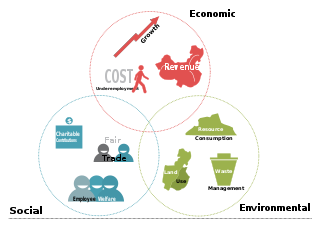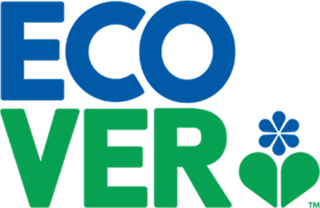
The triple bottom line is an accounting framework with three parts: social, environmental and economic. Some organizations have adopted the TBL framework to evaluate their performance in a broader perspective to create greater business value. Business writer John Elkington claims to have coined the phrase in 1994.

Greenwashing, also called green sheen, is a form of advertising or marketing spin in which green PR and green marketing are deceptively used to persuade the public that an organization's products, aims, and policies are environmentally friendly. Companies that intentionally take up greenwashing communication strategies often do so to distance themselves from their environmental lapses or those of their suppliers.
Ethical consumerism is a type of consumer activism based on the concept of dollar voting. People practice it by buying ethically made products that support small-scale manufacturers or local artisans and protect animals and the environment, while boycotting products that exploit children as workers, are tested on animals, or damage the environment.
Eco-capitalism, also known as environmental capitalism or (sometimes) green capitalism, is the view that capital exists in nature as "natural capital" on which all wealth depends. Therefore, governments should use market-based policy-instruments to resolve environmental problems.
A sustainable business, or a green business, is an enterprise that has a minimal negative impact or potentially a positive effect on the global or local environment, community, society, or economy—a business that strives to meet the triple bottom line. They cluster under different groupings and the whole is sometimes referred to as "green capitalism." Often, sustainable businesses have progressive environmental and human rights policies. In general, a business is described as green if it matches the following four criteria:
- It incorporates principles of sustainability into each of its business decisions.
- It supplies environmentally friendly products or services that replace demand for nongreen products and/or services.
- It is greener than traditional competition.
- It has made an enduring commitment to environmental principles in its business operations.
Green brands are those brands that consumers associate with environmental conservation and sustainable business practices.
Sustainability advertising is communications geared towards promoting social, economic and environmental benefits (sustainability) of products, services or actions through paid advertising in media in order to encourage responsible behavior of consumers.
Green marketing is the marketing of products that are presumed to be environmentally safe. It incorporates a broad range of activities, including product modification, changes to the production process, sustainable packaging, as well as modifying advertising. Yet defining green marketing is not a simple task where several meanings intersect and contradict each other; an example of this will be the existence of varying social, environmental and retail definitions attached to this term. Other similar terms used are environmental marketing and ecological marketing.
Ethical marketing refers to the application of marketing ethics into the marketing process. Briefly, marketing ethics refers to the philosophical examination, from a moral standpoint, of particular marketing issues that are matters of moral judgment. Ethical marketing generally results in a more socially responsible and culturally sensitive business community. The establishment of marketing ethics has the potential to benefit society as a whole, both in the short- and long-term. Ethical marketing should be part of business ethics in the sense that marketing forms a significant part of any business model. Study of Ethical marketing should be included in applied ethics and involves examination of whether or not an honest and factual representation of a product or service has been delivered in a framework of cultural and social values.

Ecover is a Belgian company that manufactures ecologically sound cleaning products, owned by S. C. Johnson & Son since 2017.
Societal responsibility of marketing is a marketing concept that holds that a company should make marketing decisions not only by considering consumers' wants, the company's requirements, but also society's long-term interests.

A green company, also known as an environmentally friendly or sustainable business, is an organization that conducts itself in a way that minimizes harm to the environment. Examples of these actions may include the conservation of natural resources, efforts to reduce carbon emissions, a reduction of waste creation, and support of ecological conservation. Green companies often implement environmentally responsible practices across their entire value chain, from sourcing raw materials to manufacturing processes and distribution.
Ecologic Brands Inc. is a United States company that specializes in creating eco-friendly packaging solutions for consumer products. The products are made from sustainable materials and are designed to be recyclable or compostable. The company also provides branding and marketing services to help companies promote their environmentally conscious products.
Sustainable products are products who are either sustainability sourced, manufactured or processed that provide environmental, social and economic benefits while protecting public health and environment over their whole life cycle, from the extraction of raw materials until the final disposal.
Sustainable distribution refers to any means of transportation / hauling of goods between vendor and purchaser with lowest possible impact on the ecological and social environment, and includes the whole distribution process from storage, order processing and picking, packaging, improved vehicle loadings, delivery to the customer or purchaser and taking back packaging.
Choice editing refers to the active process of controlling or limiting the choices available to consumers so as to drive to an end goal, specifically by banning things or imposing punitive taxation. The term has gained currency in discussions about sustainability.
Sustainable consumer behavior is the sub-discipline of consumer behavior that studies why and how consumers do or do not incorporate sustainability priorities into their consumption behavior. It studies the products that consumers select, how those products are used, and how they are disposed of in pursuit of consumers' sustainability goals.
Customer cost refers not only to the price of a product, but it also encompasses the purchase costs, use costs and the post-use costs. Purchase costs consist of the cost of searching for a product, gathering information about the product and the cost of obtaining that information. Usually, the highest use costs arise for durable goods that have a high demand on resources, such as energy or water, or those with high maintenance costs. Post-use costs encompass the costs for collecting, storing and disposing of the product once the item has been discarded.
Sustainability marketing myopia is a term used in sustainability marketing referring to a distortion stemming from the overlooking of socio-environmental attributes of a sustainable product or service at the expenses of customer benefits and values. Sustainability marketing is oriented towards the whole community, its social goals and the protection of the environment. The idea of sustainability marketing myopia is rooted into conventional marketing myopia theory, as well as green marketing myopia.
Traditionally, market orientation (MO) focuses on microenvironment and the functional management of an organisation. However, contemporary organisations have widened their focus to incorporate more roles, functions and emphasis on the macro environment. Firms have been concerned with short run success and often not taken into account the long-run ecological, social and economic effects from their activities. Despite growth in the MO concept, there is still a need to reconceptualise the concept with a greater emphasis on external factors that influence a firm.




